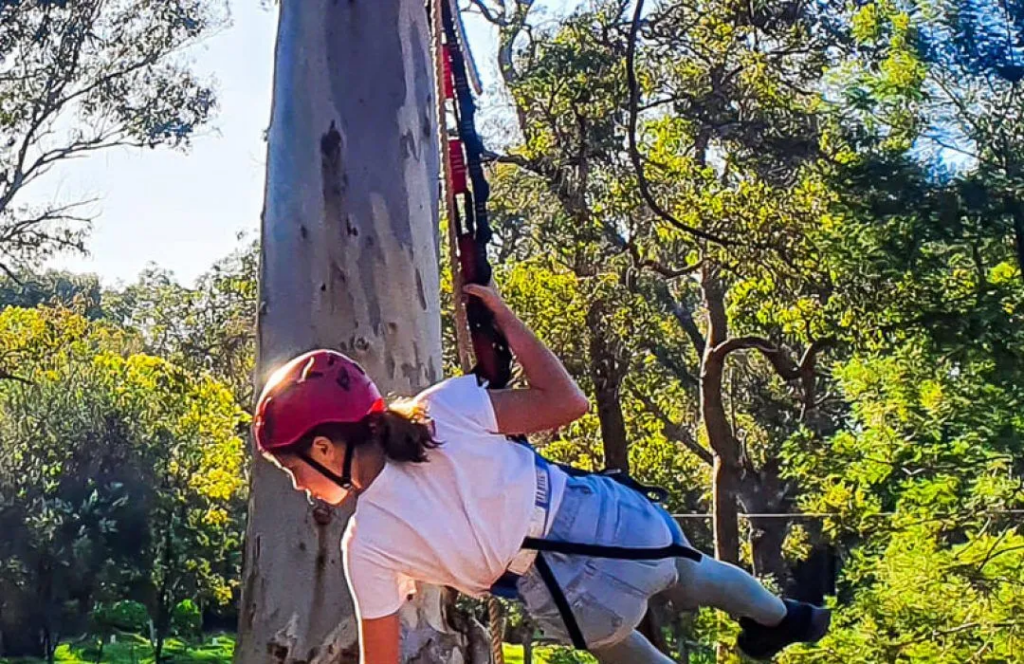
High ropes courses have become increasingly popular as a thrilling outdoor activity that combines physical challenge, mental strength, and team-building. Whether you’re looking to push your personal limits or foster camaraderie within a group, high ropes offer a unique way to achieve both. But what exactly does high ropes involve, and why has it become a go-to activity for adventure seekers and corporate teams alike?
Understanding High Ropes Courses
High ropes courses are outdoor adventure activities that typically involve navigating a series of obstacles suspended at a significant height above the ground. These obstacles can vary widely, ranging from simple balance beams to complex crossings that require teamwork and strategic thinking. Participants are securely harnessed and connected to safety lines, ensuring that while the challenges are daunting, they are also safe.
Types of High Ropes Obstacles
The variety of obstacles you might encounter on a high ropes course is vast. Here are some common types:
- Balance Beams: Narrow beams that require you to walk across while maintaining your balance.
- Swinging Logs: Logs suspended by ropes that move as you step on them, adding an extra layer of difficulty.
- Cargo Nets: Vertical or angled nets that participants must climb, testing both strength and coordination.
- Zip Lines: Often a reward for completing a course, zip lines allow participants to glide through the air from one platform to another.
- Tightropes: Thin ropes or wires that require careful foot placement and balance to cross.
- Swinging Steps: Series of steps or platforms that swing or move as you step on them, making balance and timing crucial.
Each obstacle is designed to challenge different aspects of physical and mental ability, from balance and coordination to problem-solving and communication.

The Role of Safety in High Ropes
Safety is paramount in high ropes courses. Participants are outfitted with harnesses, helmets, and gloves, and they are connected to safety lines at all times. Courses are typically overseen by trained instructors who provide guidance and ensure that safety protocols are strictly followed. Before starting, participants undergo a safety briefing that includes instructions on how to use the equipment and what to expect during the course.
Safety Equipment
- Harness: A full-body harness is used to secure participants to the safety lines, ensuring they are protected in case of a fall.
- Helmet: Helmets protect the head from any impacts, whether from obstacles or during a fall.
- Safety Lines: Continuous belay systems keep participants securely attached to a safety line throughout the course.
- Instructors: Qualified instructors monitor participants, offering assistance when needed and ensuring that everyone follows safety procedures.
The Physical and Mental Benefits of High Ropes
High ropes courses offer a range of physical and mental benefits, making them a popular choice for both individuals and groups looking to improve their fitness, mental resilience, and teamwork skills.
Physical Benefits
- Improved Strength and Endurance: Navigating obstacles like cargo nets and swinging logs requires significant upper body and core strength, while the endurance needed to complete a course provides a great cardiovascular workout.
- Enhanced Balance and Coordination: Many of the obstacles on a high ropes course are designed to test your balance and coordination, which can improve over time with practice.
- Increased Flexibility: Stretching and reaching for handholds or footholds helps improve flexibility and range of motion.
- Burning Calories: The physical exertion required to complete a high ropes course can burn a significant number of calories, making it an effective workout.
Mental Benefits
- Boosted Confidence: Successfully completing a high ropes course can give participants a sense of accomplishment and boost their self-confidence.
- Overcoming Fear: For many, the height and difficulty of the course are intimidating. Overcoming these fears can build mental resilience and reduce anxiety in other areas of life.
- Improved Focus and Concentration: High ropes courses require participants to focus on the task at hand, improving concentration and mental clarity.
- Stress Relief: Engaging in physical activity in a natural setting can reduce stress levels and promote a sense of well-being.

High Ropes for Team Building
High ropes courses are not just about individual challenges; they are also a powerful tool for team building. Many courses are designed with group activities that require collaboration, communication, and trust.
Teamwork and Communication
- Problem-Solving Challenges: Some obstacles are impossible to complete alone, requiring team members to work together to find a solution.
- Trust-Building Exercises: Activities like trust falls or group balancing tasks help build trust among team members.
- Leadership Development: High ropes courses often highlight natural leaders within a group, as participants must take charge to navigate the challenges successfully.
- Communication Skills: Clear communication is crucial in high ropes activities, as participants must coordinate their movements and strategies to complete the course.
Corporate Team Building
Many companies use high ropes courses as part of their corporate team-building programs. These courses can help break down barriers, improve teamwork, and create a sense of camaraderie among employees. By placing participants in a challenging but controlled environment, high ropes courses encourage individuals to step out of their comfort zones and rely on their colleagues for support.
Conclusion
High ropes courses offer a unique blend of physical challenge, mental stimulation, and social interaction. Whether you’re looking to push your personal limits or strengthen your team, high ropes provide a safe and exciting environment to achieve these goals.




